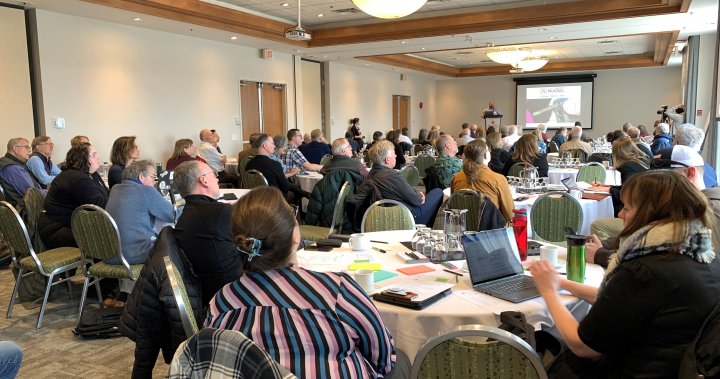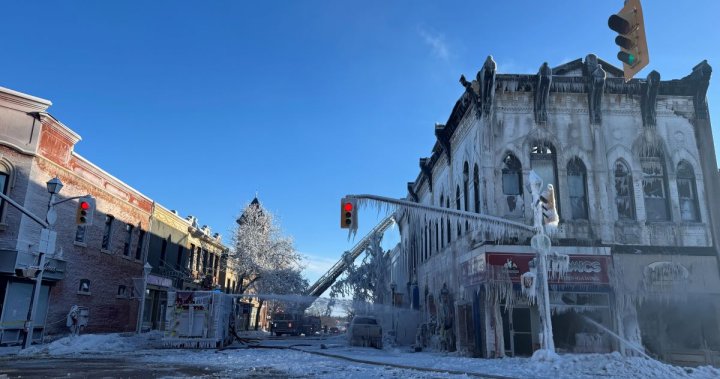Close to 100 stakeholders came together Friday morning in Kelowna to discuss more ways to prevent an invasive and damaging species of mussels from entering waterways in the region.
“This is the first time that we’ve engaged the broader community and a whole bunch of stakeholders from industry, from chambers of commerce, from tourism associations, from marinas, First Nations and local governments to get in the room together to really broaden the knowledge about the the risk to the Okanagan,” said James Littley, deputy administrator with the Okanagan Basin Water Board (OBWB).
The Quagga and Zebra mussels were first introduced in the Great Lakes in 1988 and made their way west about 10 years ago.
“Since then, they’ve been expanding and spreading throughout North America, ” Littley said. “Up until about 10 years ago, they weren’t in the west and people at the time thought, you know, they can’t really get across the continental divide. They’re not going to get across the mountains. But people drive their boats across North America and they did spread into California and Nevada.”
And now they are said to be the closest they have ever been to B.C. and the Okanagan.
“They were discovered last September in the Snake River in Idaho,” Littley said. “That’s actually water that flows into the Columbia River just like the Okanagan river does. So they’re in our broader shared water system now, and they’re only a day’s drive, less than a day’s drive from the Okanagan.”
The invasive mussels have the potential to cause millions of dollars in economic and environmental damage.
The email you need for the day’s
top news stories from Canada and around the world.
“Our infrastructure, our water intakes would get clogged with these mussels. Our drinking water costs would go up. We might have to spend hundreds of millions of dollars on new water filtration plants, for example, it will collapse our fisheries, it will destroy the ecosystems in the lake.” Littley said. “The risk is very high. Our water is the perfect type of water chemistry that you need for these invasive species to come in and thrive and we are also a prime boating destination.”
The primary way the mussels are spread is on boats when the vessels are not cleaned, drained and dried.
“They can be carried in water or they can live out of water for up to 30 days,’ Littley said.
OBWB has long called for mandatory inspections of all boats entering B.C., not just the ones that pass by inspection stations but so far government has not mandated it.
The inaugural meeting is the first of more to come as stakeholders work to come with ways to keep the mussels at bay and prepare a regional response should they find their way to the Okanagan.
“The longer we can delay them, the more we can do to prepare,” Littley said.
Stakeholders attending the meeting echoed the concerns of the OBWB.
“It would be huge,” said Eve Layman with the Thompson Okanagan Tourism Association. “If you look at the change that Lake Winnipeg had over just a mere five years…there aresections of the beaches that become unwalkable because of the shells.”
According to the Central Okanagan Economic Development Commission, the latest projections in economic impact are anywhere between $42 million and $129 million annually.
“And we think that’s likely a starting point,” said Krista Mallory, manager of the Central Okanagan Economic Development Commission. “It’s a massive concern not just to our tourism industry, our agriculture sector, our infrastructure in the region but also for our quality of life and what we know attracts people and companies and business to the region. It has the potential to have a massive impact.”
In an email to Global News, the Ministry of Water, Land and Resource Stewardship said Invasive Mussel Defence Program is a priority for the B.C. government, and that it is advocating to the federal government to maintain or grow their contributions
The ministry added that 43 inspectors operated six inspection stations and two roving inspection crews in 2023.
It added that B.C. has had to temporarily redirect funds from other programs to maintain the Invasive Mussel Defence Program service levels because of reductions in financial contributions from funding partners.
For its part, the Department of Fisheries and Oceans Canada said that in May 2023, it announced $8.75 million in contribution funding over five years as part of the newly created Aquatic Invasive Species and Prevention Fund (AISPF).
The AISPF funds eligible organizations and projects that focus on preventing the introduction and establishment of aquatic invasive species across Canada.
Last month, DFO said it announced funding of up to $540,000 from 2023 to 2025 for the Habitat Conservation Trust Foundation (HCTF), through the AISPF to support the ongoing work of the B.C.’s existing Invasive Mussel Defense Program.
DFO stated it’s also investing $90,000 to acquire two new decontamination trailers in B.C. to help educate the public on the importance of cleaning, draining and drying their watercraft before moving between bodies of water.
But stakeholders say a lot more resources are needed to ensure the invasive species does not contaminate local waters.
“We just need an upswell of support from everyone to tell the government that it’s a fraction of the cost to prevent them from coming here as it would be if they got here,” Littley said.
© 2024 Global News, a division of Corus Entertainment Inc.




